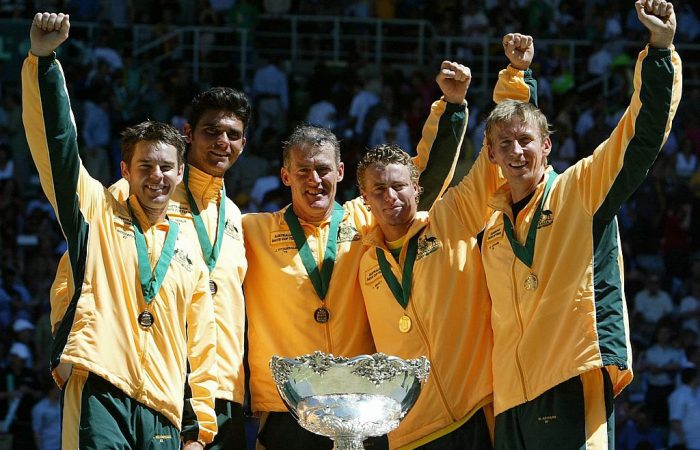Flashback Friday: Australia’s 2003 Davis Cup victory
In our Flashback Friday series, we look back at Australia’s thrilling 2003 Davis Cup final triumph against Spain in Melbourne.
Melbourne, Australia, 27 November 2020 | Leigh Rogers

The Australian Davis Cup team recorded a sensational victory in the 2003 final.
Played on an installed grass court at Rod Laver Arena, Australia faced a Spanish team boasting two of the world’s top-eight ranked players.
Having lost a home final against France at Rod Laver Arena in 2001, the Australian team were extra determined not to let this opportunity slip.
Mark Philippoussis, who was ranked No.9 and aged 27 at the time, admitted the Australian team felt heightened pressure playing at home.
“On grass and against Spain, even though they were an incredibly tough team to play against, we were expected to win,” Philippoussis recalls.
“The great thing about Davis Cup is there is no such thing as that. On any given day anyone can beat anyone.”
A steely effort from Lleyton Hewitt gave Australia the perfect start.
The 22-year-old Hewitt had skipped the final months of the ATP Tour season to prepare and train on grass ahead of the Davis Cup final. It meant his ranking, which was as high as No.1 in June, had tumbled to No.17.
The dedication paid dividends, though, with Hewitt recording a five-set victory against world No.3 Juan Carlos Ferrero in the opening rubber.
Hewitt played a starring role throughout Australia’s Davis Cup campaign in 2003, winning all six matches he played. This included his famous recovery from a two-sets-to-love deficit to defeat Switzerland’s Roger Federer in the semifinals.
World No.7 Carlos Moya then levelled the tie for Spain, beating Philippoussis in four sets.
Australia edged ahead again after the doubles, with Wayne Arthurs and Todd Woodbridge combining brilliantly to clinch the crucial rubber. The Aussies lost only seven games against Spanish pair Alex Corretja and Feliciano Lopez.
It gave Australia a 2-1 lead and needing one more rubber for victory going into the final day.
Philippoussis raced to a two-sets-to-love lead in the first reverse singles rubber – but as the big-serving Aussie struggled with a shoulder injury, Ferrero roared back to win the next two sets.
Refusing to give in, Philippoussis lifted in the deciding set and clinched it without dropping a game.
| Davis Cup 2003 final – Australia d Spain 3-1 Melbourne, Australia, 28-30 November |
|
| 1 | Lleyton Hewitt (AUS) d Juan Carlos Ferrero (ESP) 3-6 6-3 3-6 7-6(0) 6-2 |
| 2 | Carlos Moya (ESP) d Mark Philippoussis (AUS) 6-4 6-4 4-6 7-6(4) |
| 3 | Wayne Arthurs/Todd Woodbridge (AUS) d Alex Corretja/Feliciano Lopez (ESP) 6-3 6-1 6-3 |
| 4 | Mark Philippoussis (AUS) d Juan Carlos Ferrero (ESP) 7-5 6-3 1-6 2-6 6-0 |
| 5 | Lleyton Hewitt (AUS) v Carlos Moya (ESP) Not played |
“I still to this day don’t know how, but I won the fifth set 6-0,” Philippoussis admits.
“All I was saying to myself was just take one point at a time, that’s all I could do. This is Davis Cup, you leave your heart out there and that’s what I said to myself. Fitzy (captain John Fitzgerald) was on the side of the court just telling me to take it one point at a time.
“I still didn’t believe I would win this match, even on match point, until I put that ball away. When I did, I just collapsed to the ground. That was definitely, I’d have to say, one of the proudest moments of my tennis career.”
Television commentator Sandy Roberts anointed Philippoussis “a new national hero” – a sentiment a 15,000-strong Rod Laver Arena crowd agreed with, giving the ‘Scud’ a standing ovation for his efforts.
Revealing he “felt numb” in the final set, Philippoussis was quick to also pay credit to his team-mates.
“Every time we play together, it gets better and better. We combine so well,” he said.
“Davis Cup is something that brings you together as a team – that’s what makes it even more special.”
It was Australia’s 28th Davis Cup title – and remains the nation’s most recent triumph in the prestigious team competition.